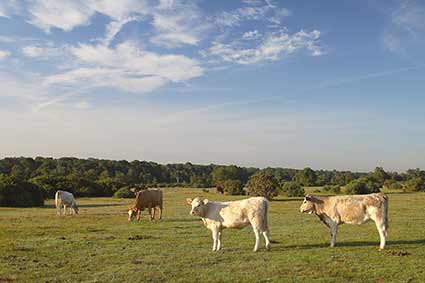Re-seeded grasslands

The Second World War brought many hardships to the people of Britain, including quite severe food shortages, so-much-so that a number of places in the New Forest were ploughed and used to grow cereals, potatoes, turnips, rape and flax.
New Forest commoners and their stock were, though, to subsequently benefit in another way, for between 1940 and 1947, and in the early and late 1950s, the extent and quality of grazing was improved by sowing grass and other seeds in the places where crops had been grown, or growth had been attempted.
The land was ploughed, and eventually lightly fertilised, limed and re-seeded. Early attempts at Ober Heath, Longcross Plain and Long Bottom were not fenced to exclude stock, and quickly reverted to natural vegetation, but subsequent examples were fenced, with consequent improved success.
These later re-seeded lawns are at Spy Holms, near Burley; Longslade Bottom; Yewtree Bottom; Whitefield Moor, near Brockenhurst; Wootton; Wilverley Plain; and around the old war-time airfields at Stoney Cross, Hatchet Moor – Beaulieu, and Holmsley. The late-1950s lawns are at Fritham Plain, King’s Garden and Thorney Hill.
However, at Black Knowl, near Brockenhurst, and at Wootton, the land was found to be too wet to support crops, so drainage was improved using ridge-and-furrow-type ploughing, and the land immediately re-seeded.
But only in the 1949 New Forest Act was this cropping and re-seeding legalised, albeit with strict conditions specified – war-time priorities had previously taken precedence.
Today, the lawns continue to attract commoners’ stock, and also support a rich variety of low-growing plants able to survive the grazing pressure. Heather, though, is slowly returning to many, as natural succession to heathland takes place.
References:
The New Forest – A Natural History: Colin R. Tubbs
More links
Other related links
Search this site

Sadly, 58 animals were killed - 35 ponies, 13 cows, 8 donkeys and 2 sheep, whilst a further 32 were injured - 3 pigs, 9 donkeys, 11 cows and 9 ponies.
(Forty-three accidents occurred in daylight, 15 at twilight and 101 in the dark. Twenty-seven accidents were not reported by the driver involved).
Here's just one horrific example - Three donkeys killed in collision with van at notorious New Forest blackspot (Advertiser and Times)

